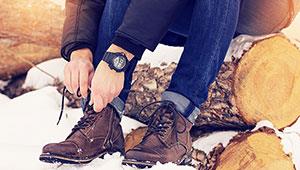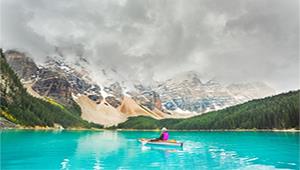Winter Gear and Gadgets
Beyond clothing, camping in the snow requires winter-specific gear. Mother Nature can get aggressive in the winter, but the right gear can help keep her at bay. First up: shelter from the snow.
4-Season Tent: These are somewhat heavier than standard 3-season tents to offer better snow and wind protection. Look for a dome shape with extra-strong poles and guy lines for stability in windy conditions. Choose solid fabric over mesh, dual doors for easier access, and a large vestibule for sheltered cooking and wet gear storage.
A few extra add-ons can make a big difference too. A gear attic helps to get small items up off the floor, and a ground cloth helps keep melted snow from seeping into the tent.
Tips to Set Up Your Tent in the Snow:
- Position the tent near natural wind protection, if available, and away from avalanche danger and falling trees or branches.
- A sunny spot will warm you in the morning.
- If wind shelter is not available, build a snow wall, or dig down in deep snow to reduce wind impact.
- Pack down the snow before setting up the tent. Loose snow can be melted by body heat, leaving you with an uneven floor to sleep upon.
- Make note of landmarks so you can find your site in the dark.
Winter Sleeping Bag: A winter sleeping bag rated for at least 10 degrees F below the coldest temperature you expect is best. You can always open it up if you get too warm.Add a sleeping bag liner to keep the interior of your bag cleaner, and warmer, and closed-cell and self-inflating sleeping pads.
How to Use:
- Insert the sleeping bag liner inside your sleeping bag.
- Place the closed-cell sleeping pad on the floor of your tent with the self-inflating pad on top.Y
- our sleeping bag goes on top of the pads.
Backpack: Even if you're going out just for a short hike, a backpack with packaged food rations, water, first-aid kit, fire starting kit, camping knife, and compass and maps are a must. A pocket stove and small pot are desirable to melt snow for drinking water. And if you're carrying skis or snowshoes, make sure the pack has tie-on points to secure these items.
Lighting and Batteries: You can keep both hands free by wearing a headlamp instead of carrying a flashlight. And because winter nights are long, make sure your batteries are new or fully charged before a trek, and always take extras.
Lithium batteries are good for cold weather, but can overpower some headlamps so check the owner's manual. Alkaline batteries are inexpensive, but they drain at a faster rate. Tip: Batteries don't like cold, so store yours and battery-operated devices inside your sleeping bag to keep them warm.
Communications
Mobile phone service is mostly non-existent in the backwoods, so two-way radios are the way to keep in touch with other members of your expedition. Some models tout ranges of 10 miles or more, but that is line-of-sight--something rare in heavily forested regions.
- 2
- of
- 3









Discuss This Article